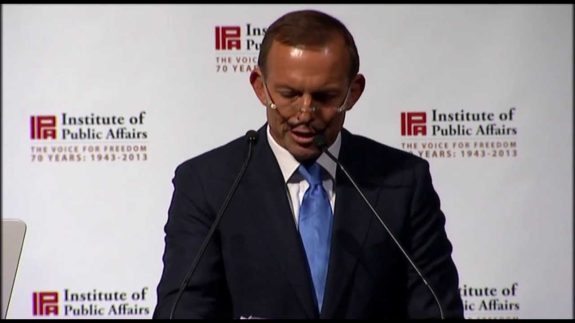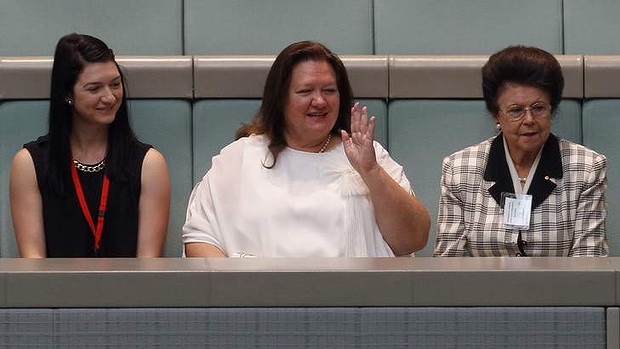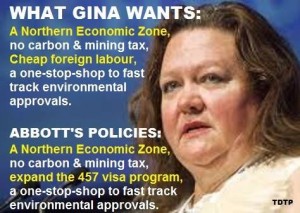What Gina wants, Gina gets

In 2012, Gina Rinehart self-published a book called Northern Australia and then some: Changes We Need to Make Our Country Rich. In it she calls for northern Australia to become a special economic zone with tax and red-tape exemptions.
At the time, Tony Abbott rejected Mrs Rinehart’s calls, declaring it was “not something that the Coalition considered and it’s not something that the Coalition is planning for”.
In what has since come to be the usual course of events, he was contradicted by his Treasury spokesman, Joe Hockey, who said the Coalition was committed to boosting investment and a northern economic zone was on the table.
“We want to explore it, but it is a long-term plan and it needs further discussion,” Mr Hockey said.
Barnaby Joyce, a close friend of Gina’s, said “If you believe in developing northern and regional Australia, it is quite obvious that you need to develop policies that attract people to northern Australia, otherwise it’s just rhetorical flourish with no substance behind it.” And it appears Gina is getting her way with the plan once again under discussion.
“There are some forms of tax concession which would be under constitutional prohibition but obviously if it’s constitutionally acceptable, and there are some things which are constitutionally acceptable, there would be no reason why it couldn’t be looked at by the White Paper.” – Tony Abbott in Darwin on 28 February 2014.
While in opposition, the Coalition flagged a plan to build 100 new dams across the country as part of a plan to prevent floods, fuel power stations and irrigate food bowls.
The total cost of the coalition’s water management plan, if all projects were approved, would be $30 billion. They included new dams for the Hunter Valley and along the Lachlan River in NSW and a $500 million plan to raise Warragamba Dam as well as a proposal to pipe water 1500 kilometres from the Kimberley to Perth.
After the idea was widely panned, the Coalition sought to distance itself from the leaked report, saying it had no specific plan yet to build 100 dams across Australia. But that was then, and this is now. With the IPA and ANDEV pushing for dams to be built, it’s very much back on the agenda.
In a review of past developments in northern Australia, Woinarski and Dawson (1997) commented that there was “a pattern of general disregard for information and scant concern for environmental consequences of success (or failure)” and that there was a perception that the environment in the north of Australia was “so extensive and of so little value that little safeguard needs to be built into development proposals”.
Changing community values shifted community and government focus to water efficiency, full cost recovery, water trading, separating water rights from land title, integrated water resource management and acknowledgement of the environment as a legitimate user of water.
But it appears we have taken a step backwards with Barnaby Joyce overseeing a Commonwealth ministerial working group which includes Deputy Prime Minister Warren Truss, Environment Minister Greg Hunt, Assistant Minister for Infrastructure and Regional Development Jamie Briggs and Parliamentary Secretary to the Minister for the Environment, Senator Simon Birmingham.
Mr Joyce said that water infrastructure had to keep pace with economic opportunities in Australia’s region and that we “have to take advantage of the growing wealth of hundreds of millions of people who live close by.”
“We have the Treasurer today talking about the recycling of capital. One of the most effective forms of recycling of capital is in water infrastructure, because water is wealth.” As with everything else, it’s all about the money.
Previous reports, such as one completed by the CSIRO in 2010, have found that very few sites are suitable or near locations where there is likely to be significant demand for water.
Capturing and keeping streamflow in northern Australia is difficult. Most of the rainfall occurs near the coast where it is mostly too flat to build dams. Capturing water in valleys doesn’t overcome the problem of evaporation unless the dams are very deep. Consequently, large scale dams (like Lake Argyle) that can provide year-round water are not likely to be feasible for most of the north.
Mr Joyce rejects that, however.
“I disagree with some of the issues that CSIRO have reported in the past, that you couldn’t have any more irrigation capacity, because it was manipulated by the [then Labor] government in such a way as the report was confounded.
“It had to come out with that sort of recommendation because the government put so many caveats on things that you weren’t allowed to do,” he said.
Concern about equity in decision making, the health of land, river and sea environments, Indigenous livelihoods, security, infrastructure and social wellbeing are no longer important in discussions revolving around gigalitres of water, hectares of land or tonnes or dollars of production.
Northern Australia is characterised by high year-round temperatures, a distinct seasonal rainfall pattern, some of the greatest rainfall intensities in the world, large inter-annual variability in rainfall and large evaporation rates.
The lack of rainfall during the dry (winter) months means that irrigation is essential for cultivated agriculture or perennial horticulture during this period. The strong seasonal component to rainfall and the high evaporation rates in northern Australia mean that a greater volume of water (between 20 and 80%) is required to irrigate a given area of perennial pasture in the North than in the South.
Large variation in flow from season to season and from year to year requires that sizeable storage structures would have to be built to accommodate volume fluctuations and meet demand of permanent settlements and irrigation during the dry season unless suitable groundwater resources are available
40% of Australia’s total potentially exploitable water is located in northern Australia. If all of this potentially exploitable water was used for irrigation, 20 to 25% of Australia’s irrigation by area could theoretically be located in northern Australia. In reality, however, the maximum area under irrigation will be significantly less than this (est 60,000 ha) when environmental, social, cultural and other values are considered in the water allocation planning process.
While these estimates suggest that from a purely water volume point of view there is potential for additional irrigation in northern Australia, efforts towards achieving and maintaining sustainable irrigation in southern Australia will continue to be central to Australia’s long term irrigation future.
Sustainable irrigation with groundwater in semi-arid and arid zones will require a recharge area that is several orders of magnitude greater than the irrigated area. If groundwater is developed in these arid zones, it may be very challenging to maintain existing ecological values.
Because most rivers in northern Australia are ephemeral, perennial rivers have high ecological significance. Any extraction of groundwater from these systems will most likely result in a reduction in streamflow at some point in time. The impacts of these reductions and whether those impacts are acceptable is a key management question.
Experience in northern irrigation schemes, e.g. the Ord and Lower Burdekin, illustrate that failure to manage deep drainage accessions will result in irrigation-induced salinity. In the wet-dry tropics of northern Australia groundwater levels may seasonally fluctuate by as much as 10 m. These seasonal fluctuations are considerably greater than those experienced in irrigation districts in southern Australia.
The Coalition want “A food bowl including premium produce which could help to double Australian agricultural output”, but history shows us that previous attempts have been largely unsuccessful.
The Ord Irrigation Project has cost over a billion dollars over 60 years, with no cost benefit analysis.
Cotton thrived between 1963 and 1974 but insect pests required millions of litres of pesticides and when the government removed price subsidies it collapsed.
Rice came and went for similar reasons with magpie geese blackening the sky and closing the airport so thick were the numbers.
Sugar came and collapsed when production failed to meet anywhere near the amount required to keep the mill viable and the price collapsed.
Buoyed by the potential of new varieties in 2010 farmers planted the first commercial rice crops in the region for 30 years. After two promising years the fungal disease rice blast was discovered rendering the crops worthless.
Similarly driven by strong global prices a number of farmers grew cotton last year but cold weather reduced yields by half and a wet picking season further reduced production.
Neither rice nor cotton will be grown again this year.
The Ord now hosts the largest commercial Indian Sandalwood production in the world covering more than 60% of the land under cultivation, and has supplanted melons, pumpkins, chick peas, bananas and so on. This is a tree that takes 14-20 years to maturity and provides nothing edible.
Whether it be tax zones, or dams, or food bowls – forget the science, forget the experts, forget the environment, forget the lessons of the past, and the traditional owners – what Gina wants, Gina gets.
More great reading from Kaye Lee:
Hi ho, Hi ho….where am I spose to go?
It’s all about the choices you make
My kids are ok, yours can go beg.














